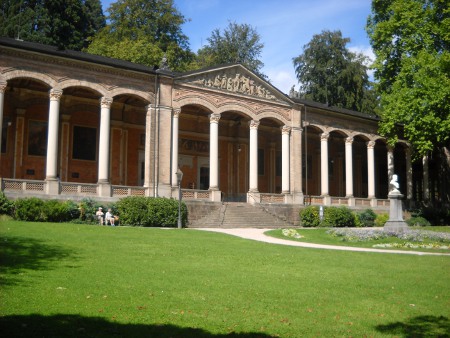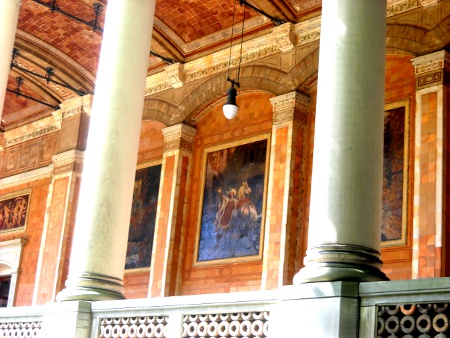The Trinkhalle Baden-Baden stands next to the Kurhaus with the Casino Baden-Baden in the centre of the city. In the overwhelming 90-metre-long building, the healing water was and is dispensed to the spa guests.

Today, the Trinkhalle houses good tourist information in Baden-Baden. You can get a lot of information material, and questions are answered in detail and competently. The tourist information centre also offers advance ticket sales.
In addition, you can sample the healing waters of Baden-Baden. For only 20 cents, you get a cup that you fill up yourself with the water. The water is hot and tastes a little like chemicals. There is a notice above the tap that you should not drink more than 125 ml per day.

The Trinkhalle Baden-Baden is particularly impressive from the outside. Between the huge columns in the ancient Greek style are 16 oversized murals. The 19th-century paintings by Jakob Götzenberger depict scenes from old legends and anecdotes from the Black Forest.
These open colonnades with the healing springs are also called colonnades. In addition to the colonnades of Baden Baden, the buildings around the hot springs in Karlovy Vary / Czech Republic are also among the most beautiful in Europe. More info on this link
Trinkhalle Baden-Baden More info
The Trinkhalle in Baden-Baden is a reminder of the city’s rich gymnasium culture and its literal significance in European high society. The neoclassical building in the centre of Baden-Baden not only served as a place to relax, but also developed into a social meeting place for the nobility. The present work takes an in-depth look at the history and significance of the Baden-Baden Trinkhalle.
Origins
Baden-Baden has long been associated with hot healing springs, which are said to date back to Roman times. In the 19th century, there was a renewed interest in these springs and the Trinkhalle was established as a place where visitors could enjoy the restorative waters.
Built between 1839 and 1842, the Trinkhalle was part of a wider urban development concept designed to make Baden-Baden one of Europe’s leading health resorts. The mineral-rich water was said to have numerous health benefits, particularly for diseases of the digestive tract and urinary tract.
Architectural marvel
The drinking hall, designed by Heinrich Hübsch, is a mixture of Biedermeier elements and neoclassical echoes. Its most striking feature is a 90-cadence-long veranda adorned with 16 Corinthian columns. This promenade is covered with oil paintings by Jakob Götzenberger depicting legends and myths from the region.
The main hall of the drinking hall, where the spring water was once distributed, is a testament to architectural grandeur. The vaulted ceilings, elaborate stucco work and ornate chandeliers reflect the importance that the society of the time attached to health and substance.
Social and artistic significance
In addition to its primary function as a Mecca for medicinal water, the Trinkhalle soon developed into an important social centre. European nobility, artists, writers and thinkers frequently met here. For many, it was part of their daily routine to partake of the water, then linger under the veranda or in the neighbouring spa halls, culminating in soirées and gatherings in the evening.
Even though the age of European spa culture is over, the Trinkhalle remains a living symbol of Baden’s history. Although the building no longer serves its original purpose of distributing spring water, it is still a centre of attraction for visitors. Visitors are often seen appreciating the oils, taking part in guided tours or simply enjoying the calm air.
The Trinkhalle also frequently hosts artistic events, exhibitions and musicals, continuing its legacy as a central meeting place.
The Baden-Baden tourist information centre is located in the immediate vicinity of the Trinkhalle,